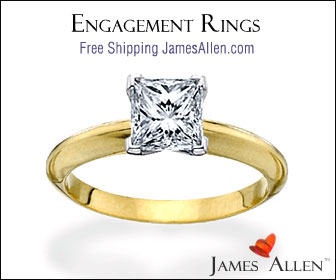Diamond Cut
The cut of a diamond is a general measure of how well it shines, or in other words its brilliance. There are lots and lots of factors that determine the cut of a diamond, most of which probably don't matter to a typical buyer. The basic idea is the better the cut, the more brilliant it appears, and the more expensive it will be. Not all jewellery stores will be able to tell you what the cut of a particular diamond is in their store, but many online retailers will provide a rating. Institutes like the Gemological Institute of America (GIA) will provide reports for a diamond which include, among other details, the 'cut' rating of a diamond.
Sponsored Links
Difference Between Cut and Shape
Sometimes it can get confusing when reading online or talking to jewellers about 'cut', because some people will mix up the 'cut' of a diamond with the 'shape' of a diamond. The shape of a diamond is whether it's round, or square etc. The cut refers to how well the diamond has physically been cut up and shaped to best react with light.
Cut Ratings
Different retailers and institutes use different descriptions for cut ratings. The GIA will rate diamond cuts like this:
- Excellent
- Very Good
- Good
- Fair
- Poor
Other retailers will have other descriptions such as "signature cut" or "ideal cut". Some of them will also explain how their rating system relates to one such as the GIA's.
Polish
Polish is all about how smooth each facet of the diamond is. The facets are all the flat faces of the diamond. A poorly polished diamond may appear duller.
Symmetry
The symmetry of the diamond refers to how well aligned all the different facets of the diamond are. Poor symmetry means that light entering the diamond may not follow an optimal path. The result - the diamond won't look as good.
Other Terms Relating to Diamond Cut
|
Term
|
Description |
| Depth | The 'height' of the gemstone as measured from the table to the culet (see these terms later in the table). |
| Girdle | The part of the diamond between the top and bottom halves - i.e. between the crown and the pavilion. |
| Diameter | The total width (not the radius) of a diamond measured at the girdle, usually the widest part of the diamond. |
| Culet |
The bottom 'tip' of the diamond. Sometimes the 'tip' will be a very small facet (flat surface), rather than a sharp point.
|
| Table |
These are 'Included' diamonds and will have flaws visible to the naked eye. You'll find these in jewellers as diamonds which are quite affordable for the size.
|
| Pavilion | The bottom half of a diamond, between the girdle and the culet. |
| Crown | The top part of the diamond, the part above the girdle. |
Get started designing your ring now at James Allen by clicking on the banner below:


